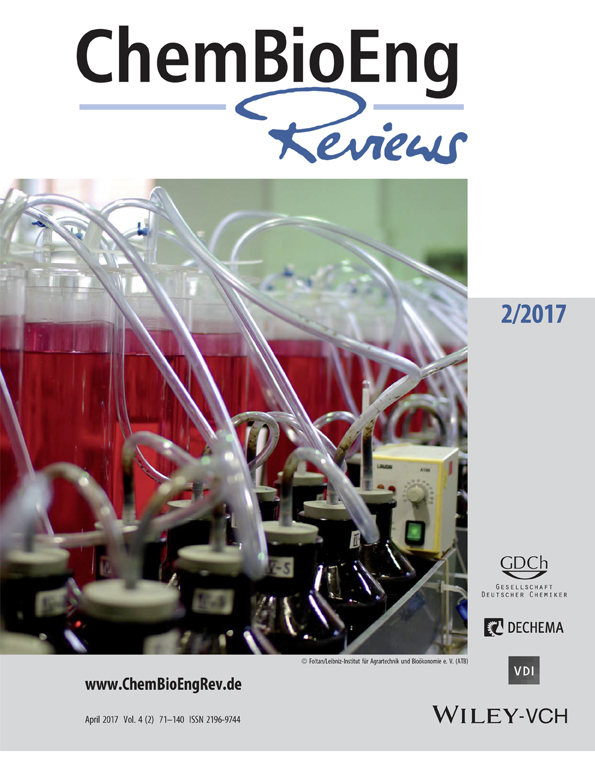Bioethylene Production from Ethanol: A Review and Techno-economical Evaluation
Abstract
Manufacturing of bioethylene via dehydration of bioethanol is an alternative to the fossil-based ethylene production and decreases the environmental consequences for this chemical commodity. A few industrial plants that utilize 1st generation bioethanol for the bioethylene production already exist, although not functioning without subsidiaries. However, there is still no process producing ethylene from 2nd generation bioethanol. This study is divided into two parts. Different ethanol and ethylene production methods, the process specifications and current technologies are briefly discussed in the first part. In the second part, a techno-economic analysis of a bioethylene plant was performed using Aspen® plus and Aspen Process Economic Analyzer, where different qualities of ethanol were considered. The results show that impurities in the ethanol feed have no significant effect on the quality of the produced polymer-grade bioethylene. The capacity of the ethylene storage tank significantly affects the capital costs of the process.
1 Introduction
Concerns about global warming and climate change due to greenhouse gas emissions encourage making use of renewable energy and materials instead of fossil fuels. The polymer market is not an exception 1, 2, where bio-based polymer production capacity is estimated to be tripled from 5.7 million t in 2014 to 17 million t in 2017 3. The current global market size for ethylene accounts for 127 million t which is by far the largest commercial chemical produced by volume 4.
Ethylene or ethene (CH2=CH2) is the first member of the alkenes. It is a colorless gas with a normal boiling point of –103.7 °C and is slightly soluble in water and alcohol. This compound is highly active and reacts easily when added to many chemical reagents. For instance, addition of water to ethylene produces ethyl alcohol or ethanol. Ethylene is a good starter molecule to build on due to its simple chemical formula combined with the double bond. It is also the raw material for the production of different grades of polyethylene and other bulk and base chemicals 5, 6. Straight chain olefins can be produced by the oligomerization of ethylene through a process developed by Shell called the Shell higher olefin process (SHOP). These higher chain hydrocarbons (α-olefins) are used primarily as comonomers to produce linear low-density polyethylene and to manufacture detergents and synthetic lubricants as well as gasoline, diesel, and jet blend stocks 5-8. For example, ethylene oxide, produced by oxidation of ethylene, is a key raw material in the production of surfactants and detergents. Another major chemical intermediate obtained by alkylation of ethylene is ethylbenzene which is precursor for styrene production. Styrene is utilized for manufacturing of polystyrene for insulation, packaging, rubber for tires, and footwear 5, 6.
In petrochemical industries, ethylene is produced mainly by cracking of naphtha 5. One of the relatively old applications of ethylene was its hydration to produce synthetic ethanol. This technology had a high share of ethanol market in 19th century 9. However, due to the rapid expansion of bioethanol or fermentative ethanol production from sugar and grains since 1980s, the share of synthetic ethanol in the market dropped rapidly. In addition, it opened up production of bio-based ethylene or bioethylene using the reverse process of producing bioethylene from bioethanol 10. Bioethylene can be used by existing equipment since bioethylene and ethylene are chemically identical 11.
According to a 2013 joint brief by the International Renewable Energy Agency 11 and the Energy Technology Systems Analysis Programme (ETSAP), 0.3 % of the global capacity of ethylene is produced from bioethanol. There are commercial facilities producing bioethylene located in Brazil and India, and also several production plants are under construction or planned (e.g., in China). The largest bioethylene producer is located in Brazil with a production capacity of 200 kt a−1 of bio-ethylene 11.
Although commercial processes are currently running 12-19, there are questions that arose in several research studies. Several studies have investigated the production of ethylene from ethanol 10, 12, 20-22. Morschbacker 10 reviewed bioethanol-based ethylene as raw material for the production of bioplastics, e.g., polyethylene, with the focus on the aspects relative to the ethanol manufacture in Brazil, using sugarcane as feedstock. He concluded that ethanol conversion and the reaction selectivity have a direct impact on the yield, and consequently, on the costs of the process. He also discussed that bioethanol-based polyethylene can be an alternative to plastics that have come to the end of their life. It can be recycled mechanically or by incineration since it releases a non-fossil carbon dioxide that will be equivalent to the quantity absorbed by the sugarcane crop at the beginning of the cycle. Zhang et al. 12 also reviewed the process of ethanol to ethylene, mainly focused on the reactor design, the reaction mechanism, and the catalyst. They concluded that a fluidized bed reactor with an efficient and stable catalyst and deep understanding of the reaction mechanism will be the focus of future research. This will promote the development of the process and provide strong support for the market competiveness. A techno-economic assessment of potential processes for bioethylene production was done by Haro et al. 20. They assessed production of ethylene via dehydration of bioethanol and conversion of bio-dimethyl ether into olefins. Furthermore, they studied different cases regarding the origin of bioethanol and showed that two of those case studies including Brazilian ethanol and ethanol via indirect synthesis from syngas (carbon monoxide and hydrogen rich synthesis gas) led to cost-competitive production of ethylene at market prices in 2013. They also reported that, except for the case of bioethanol from biochemical processing, all cases would be profitable if bioenergy with carbon capture and storage (BECCS) was taken into account.
This review deals with a summary of different processes for the production of ethanol and ethylene, their operating parameters and current technologies as well as the techno-economic evaluation of the effect of impurities on ethylene production from bioethanol.
2 Ethanol Production
Ethanol can be produced by catalytic hydration of ethylene, fermentation of sugars and from lignocellulosic materials. These methods (Fig. 1) are discussed briefly in this section. More discussions on the technical readiness level and commercial plants for ethanol production can be found elsewhere 23-26.
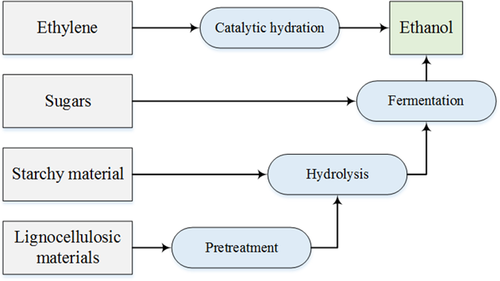
2.1 Ethanol Production from Ethylene
In the petrochemical industry, ethanol is produced via direct and indirect hydration of ethylene. Catalytic direct ethylene hydration was first introduced by Shell in 1947. In this process, ethanol is produced by a reversible exothermic reaction between ethylene and water vapor. The process consists of three different steps including reaction, recovery and purification 9, 27. The ethylene is mixed with steam with a molar ratio of 0.6 at 250–300 °C and 70–80 bar and then passes over an acidic catalyst in a fixed bed reactor. The water-to-ethylene ratio should be less than one to avoid catalyst losses. The ethylene conversion is about 4–25 % and it is recycled. The ethanol selectivity is 98.5 mol % 12, 28-30. Phosphoric (V) acid coated onto a solid silicon dioxide has been used mainly as the catalyst. Several impregnated metal phosphates (metal: Ge, Zr, Ti, and Sn) were also studied, showing slightly higher conversions compared with phosphoric acid on silica 31, 32.
A simple process diagram of direct hydration of ethylene is presented in Fig. 2. The feed stream (ethylene and water) preheated by effluent is heated up to 300 °C in the furnace. Thereafter, it enters into a packed bed catalytic reactor at 70 bar. Phosphoric acid is used as catalyst and conversion is 4–25 %. Acetaldehyde is produced as a by-product, which can either be sold or further hydrogenated to produce ethanol. The unreacted reactants are separated from the outlet vapor mixture of the reactor in a high pressure separator and then scrubbed with water to dissolve the ethanol. The recycled vapor from the scrubber contains ethylene, and the molar ratio of water to ethylene is maintained as 0.6:1. The bottom streams of the scrubber and the separator are then fed to the hydrogenator, where acetaldehyde is converted into ethanol on a nickel-packed catalyst. In the acetaldehyde separator column, the unreacted acetaldehyde is removed and recycled to the hydrogenator, and the bottom stream is fed to the light and the heavy (purifier) columns to increase the ethanol concentration 6. It should be noted that the ethanol-water mixture forms an azeotrope mixture which needs special distillation techniques which eventually increase the costs of the plant 33.
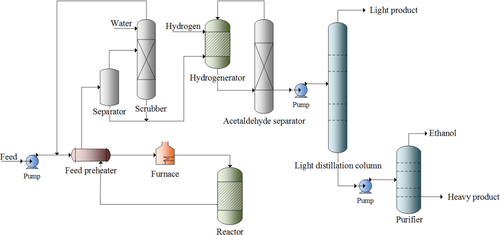
As mentioned before, the share of synthetic ethanol in the market has decreased significantly since 1980s due to the increase of bioethanol or fermentative ethanol production from sugar and grains 9, 10. According to the global statistics in 2010, only 7 % of ethanol was produced using hydration of ethylene by a few multinational companies such as Sasol in Europe and South Africa, Equistar in the USA, and SADAF in Saudi Arabia 34, 35.
Furthermore, this process is not economically feasible because ethanol is a cheaper chemical than ethylene. Also, it is non-renewable if the ethylene is produced by hydrocracking petroleum feedstocks.
2.2 Ethanol from Sugar and Starchy Materials
Microorganisms such as yeast can be employed to produce ethanol via fermentation of sugars. The 1st generation bioethanol is the ethanol produced from sources where the sugars are more easily obtainable 36. The sugars are either directly extracted from sources such as sugarcanes and sugar beet juices or obtained via hydrolysis of starchy materials such as corn and grains. Starch consists of long chain polymers of glucose and cannot be fermented directly to ethanol by conventional baker's yeast. Therefore, the macromolecular structure of starch should first be depolymerized into glucose by enzymes. Microorganisms are then employed for the production of ethanol via fermentation. There are three different categories of these microorganisms including yeast (e.g., Saccharomyces species), bacteria (e.g., Zymomonas species), and molds (e.g., Mucor species). The produced ethanol is then separated by distillation 36-38. More details about the ethanol fermentation technologies from sugar and starch feedstocks can be found elsewhere 37, 39, 40.
The two major world ethanol producers are the United States and Brazil with nameplate capacities of 56 and 30 billion L a−1 in 2016. These countries produce more than 83 % of the ethanol globally supplied. China, Canada, and European countries are other big ethanol producers. Corn starch, sugarcane, and wheat starch are the most important feedstock for production of American, Brazilian, and European ethanol, respectively 41, 42.
Ethanol production from starch feedstock can be performed through two different processes, i.e., dry milling and wet milling. In the wet milling process which is not the most popular method in industrial ethanol production, different ingredients of the grain (corn or wheat) such as protein and oil are separated prior to enzymatic hydrolysis of starch. Therefore, nearly pure starch is employed for ethanol production. However, the majority of the big ethanol production processes use the dry milling process where the whole grain is subjected to the ethanol production process. In this process the residue of the grains as well as the yeast cells produced during the fermentation are recovered as a protein-rich co-product called DDGS (dried distiller grains with solubles). This co-product brings a high positive economic impact to the ethanol process and is sold, e.g., as animal feed. Typically, 1/3 kg ethanol, 1/3 kg carbon dioxide, and 1/3 kg DDGS are produced from 1 kg of grain (corn or wheat) 43. More details of the ethanol process have been presented elsewhere 37, 39, 40.
2.3 Ethanol from Lignocellulosic Materials
Lignocellulosic materials, such as woody crops and agricultural residues can be used to produce 2nd generation bioethanol. Lignocellulosic materials have three main components including cellulose, hemicellulose, and lignin 36, 38, 44. The hydrolysis of lignocellulosic material is more difficult compared to starch due to their recalcitrance structure. Lignin forms a protective barrier for the cellulose microfibrils, which makes the cellulose hydrolysis to glucose difficult. In addition, the linkage between lignin and hemicellulose hinders the degradation of hemicellulose to pentose and hexose sugars 38, 45. The process of ethanol production from lignocellulosic biomass consists of four main steps, namely, pretreatment, hydrolysis, fermentation, and distillation 46. In the pretreatment step, the lignocellulosic structure is opened up via physical, chemical, physicochemical, or biological methods 45. Hydrolysis is the second step where the cellulose and hemicellulose molecules are degraded into monosaccharides by cellulolytic enzymes or acids 46. The sugars are then fermented to ethanol in the third step. Many microorganisms have the potential of being used in the fermentation process. Among those, the normal baker's yeast (Saccharomyces cerevisiae) is well established in large-scale production, has a high ethanol tolerance and relatively good resistance against inhibitors formed in the process. However, it does not naturally ferment pentoses 31, 46. Purification of the fermentation broth is the last step, which is mainly done by distillation.
After distillation, most of the formed by-products and other impurities are removed, leaving only traces behind. It should be mentioned that distillation is one of the most energy-intensive units and has a major impact on the overall energy demand of the process. Furthermore, the ethanol-water mixture forms an azeotrope mixture. Consequently, simple distillation techniques cannot change the composition of this mixture. This eventually increases the cost of the plant 33. Using molecular sieves is another ethanol purification technology which has become more attractive for industries since it has a lower energy consumption compared to other methods such as azeotropic distillation. Also, there is no need to use other chemicals in this process. This eliminates the chance of contamination and the cost of the usage of such chemicals 47. More details about the developments in the technology for ethanol production from lignocellulosic materials can be found elsewhere 44, 48, 49.
2.4 Ethanol from Waste Materials
A potential source of fermentable sugars that can be used to produce bioethanol is the waste biomass in the form of lignocellulosic or starch-based materials. This type of waste can be in the form of lignocellulosic materials or starch-based origin such as food waste, municipal solid waste, agricultural waste and paper waste. The overall process of bioethanol production from waste biomass is shown in Fig. 3. However, the terminology of the process steps differs based on the type of feedstock used. The major steps can be categorized as feedstock preparation, pretreatment, release of free fermentable sugars, fermentation, and purification 50.
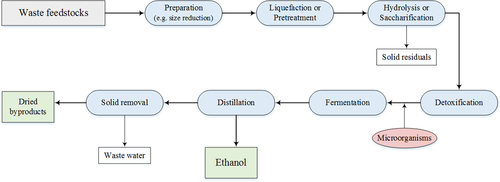
The new-generation bioethanol production processes have been greatly improved by new technologies. However, several challenges still remain, such as developing more efficient pretreatment technologies, developing and maintaining stably performing microorganisms, and integrating the attained optimal components into the economics of ethanol production systems 51.
Another process is to utilize organic wastes in the anaerobic digestion plants to produce methane. In the anaerobic digestion process, the carbonaceous matter of wastes is degraded in natural environments. In general, the feedstock is harvested or collected, coarsely shredded, and placed into a reactor containing active inoculum of microorganisms required for the methane fermentation. The produced methane in this process can be used to manufacture ethanol via methane reforming to syngas 21, 52.
2.5 Ethanol from Thermochemical Conversion Processes
One of the benefits of thermochemical processes is that a wide variety of biomass feed stocks can be utilized irrespective of their sugar and lignin contents. This method involves the gasification of biomass to syngas and then either fermentation of syngas to ethanol or catalytic conversion of the syngas to ethanol and other mixed alcohols. In the context of gas fermentation, syngas is fermented by acetogenic microorganisms to produce ethanol or other hydrocarbons that can be used as a fuel or chemical feedstock. The catalytic conversion syngas into ethanol can be direct or indirect. In the direct method, syngas is converted into ethanol (or other alcohols) in a single catalytic reaction. The indirect synthesis proceeds via dimethyl ether (DME) hydrocarbonylation to produce ethanol from syngas. The indirect synthesis has a higher efficiency and better economics since the direct synthesis has low selectivity that reduces the efficiency of the ethanol production 20, 21, 53, 54.
Several techno-economic analyses have investigated thermochemical conversion processes and showed that the biomass-derived ethanol by this method has the potential to be cost-competitive due to higher yields of ethanol per ton of biomass, as well as lower ethanol selling prices than their fermentation counterparts 21, 53-55.
3 Ethylene Production
Ethylene can be produced in plants and microorganisms or via synthetic methods such as pyrolysis of naphtha or ethane and catalytic dehydration of ethanol (Fig. 4). These methods are discussed briefly in this section.
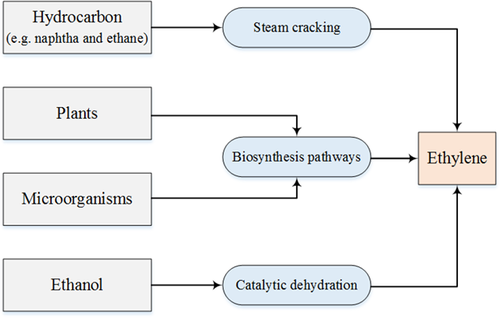
3.1 Ethylene from Petrochemicals
In the petrochemical industry, ethylene is mainly produced via steam cracking (pyrolysis) of naphtha in which feed streams are preheated and then mixed with steam with a 1:1 ratio at 750–850 °C for a short period of time (less than 0.5 s). The yield of ethylene depends on the type of feedstock used in the process. For instance, the yield of ethylene produced is about 35 % for naphtha and 80 % for ethane as feedstock 5. Using ethane as feedstock has increased since it can be extracted from natural gas. During the last decade, availability of natural gas has increased because of the development of hydraulic fracking technologies, where the gas is extracted using drilling, sand, high pressure water, and chemical solutions 56. The increase in availability of ethane has considerably decreased the ethylene raw material price. However, studies have revealed that the hydraulic fracking method can result in environmental consequences such as methane contamination of drinking water 57 and increased seismic activities 58. Besides, the traditional ethylene production processes are one of the most energy-intense chemical processes 59.
3.2 Ethylene Production by Plants
In nature, ethylene is involved in controlling events throughout the lifecycle of plants, and it is known as the plant hormone that can be sensed and produced by plants 60. Two key enzymes including ACC (1-aminocyclopropane-1carboxylic acid) synthase and oxidase (ACS and ACO, respectively) are involved in the ethylene biosynthetic pathway, where ACS converts the methionine derivative SAM (S-adenosyl methionine) into ACC and methylthioadenosin. The methylthioadenosin is then recycled and produces SAM via the Yang cycle, and the ACC is degraded by ACO into ethylene, CO2, and HCN 60-63 (Fig. 5).
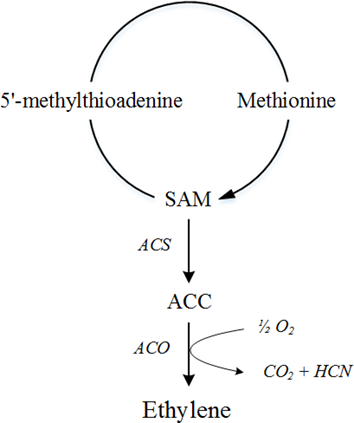
3.3 Ethylene Production by Microorganisms
Several bacterial and fungal ethylene producers have been reported since the discovery of microorganisms able to produce ethylene in the mid-1900s 63-66. Two main pathways are involved in the ethylene production in these microorganisms. The first one is called the L-methionine-dependent KMBA (2-keto-4-methylthiobutyric acid) pathway. In this pathway, L-methionine is converted into KMBA and then oxidized to ethylene via a complex reaction and formation of hydroxyl radicals 67. The second pathway is the 2-oxoglutarate-dependent EFE (ethylene forming enzyme) pathway where 2-oxoglurtarate is a key substrate 68. More details about the ethylene pathways can be found elsewhere 69.
The ethylene producing cyanobacteria has recently been shown to increase photosynthesis more than wild type cyanobacteria. Xiong et al. 70 demonstrated that ethylene can be sustainably and efficiently produced from the cyanobacterial tricarboxylic acid (TCA) cycle of the recombinant cyanobacterium.
During the last decade, the biochemical area has expanded immensely, and nowadays a vast variety of materials are produced based on biotechnological methods 71. Thus, bioethylene production using microorganisms would be of great interest in the future as alternative for the traditional petroleum based processes, which are highly energy demanding and major CO2 producer (Fig. 6). A techno-economic analysis of the ethylene production from cyanobacteria has been done by Markham et al. 72. They reported that the productivity of ethylene has the largest effect on costs and that the synergistic improvements in productivity, reactor design, and separation technologies are of great importance for reducing the costs in the long-term projection scenario. It should be noted that this technology is in the early stages.
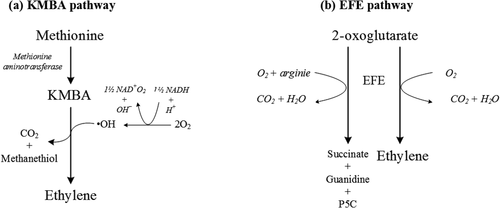
3.4 Catalytic Dehydration of Ethanol to Ethylene
Catalytic dehydration of ethanol is an alternative route for production of ethylene. The first report on catalytic dehydration of ethanol to ethylene was published in the literature in 1797 73. However, the first commercial plant was started in the beginning of the 20th century. In the industry, the alcohol dehydration mainly occurs in the vapor phase of two-catalyst systems, i.e., supported phosphoric acid and activated alumina. Most old technologies used phosphoric acid while the activated alumina became predominant later 10.
3.4.1 Reaction Conditions
The dehydration reaction occurs in the vapor phase inside fixed or fluidized-bed reactors with catalyst. The process in the fixed-bed reactor can be either isothermal or adiabatic, while it is usually adiabatic in the fluidized bed reactor.
3.4.1.1 Isothermal Fixed-bed Reactor
Since the early stages of the technology, the isothermal process was mainly used in ethanol dehydration. Usually in this process, a multi-tubular fixed-bed arrangement is used with the catalyst placed inside the tubes. A hot stream circulates in the shell side to provide the needed heat for the endothermic reaction and to maintain the temperature of the catalysts within a specific range. The operating temperature range is 330–380 °C with a liquid hourly space velocity (LHSV) of about 0.2 to 0.4 h−1. The conversion of ethanol is 98–99 % and the molar selectivity ethylene is between 95–99 %. A frequent regeneration of catalyst is necessary due to the coke deposition. An air-diluted with steam is used for this purpose, and it is done every 1–6 months depending on the catalyst and the process condition. It is more difficult to control the temperature of bigger tubes. Thus, the possibility to scale up to large capacities is limited 6, 10, 74, 75.
3.4.1.2 Adiabatic Fixed-bed Reactor
In this process, a series of fixed-bed reactors, packed with catalyst, are used. The heat needed for the reaction is supplied by an inert heat-carrying fluid. Intermediate furnaces are used to reheat the feed stream, which enters into the next reactor. The steam to ethanol weight proportion in the feed stream is typically 2:1 to 3:1. Ethanol make-up streams are added between each stage. The inlet temperature is 450–500 °C with a LHSV of about 0.15 to 0.5 h−1. The conversion is higher than 99 % and the ethylene molar selectivity is 97–99 %. The catalyst regeneration cycle is between 6 to 12 months since steam is used and coke formation is lower 10, 12, 74, 75.
3.4.1.3 Fluidized-bed Reactor
A nearly quantitative ethanol conversion with very high selectivity to ethylene can be achieved in the fluidized-bed reactor. It also allows an optimum temperature control with minimized by-product and coke formation. The conversion of ethanol is 99.5 % at 400 °C with a molar selectivity of 99.9 % to ethylene. No external heating of the reactor is needed since the hot feed and the heated catalyst (recycled from the catalyst regenerator) provide the endothermic heat for the reaction 10, 12, 75.
3.4.2 Catalysts
The dehydration of ethanol is an acid-catalyzed reaction. There are four main categories that can be used as catalyst in such a process including phosphoric acid, oxides, molecular sieves, and heteropoly acid catalysts 12.
3.4.2.1 Phosphoric Acid Catalysts
Phosphoric acid was first used as catalyst in the 1930s by loading phosphate on clay or coke. The ethylene produced from the ethanol dehydration reaction with this type of catalyst has high purity. However, the deposition of coke leads to catalyst deactivation and the regeneration takes about a month. Therefore, such catalysts have no longer been used since the 1950s 12, 76.
3.4.2.2 Oxide Catalysts
The oxide catalyst is the typical representative of activated alumina-based catalysts, which are currently used in the industrial equipment for dehydration of ethanol. Alumina can be used as both catalyst and catalyst carrier for many important chemical reactions such as the alcohol dehydration, isomerization, alkylation, and catalytic cracking. The activated alumina-based catalyst is stable and the purity of the produced ethylene is high. However, the concentration of ethanol should not be too low, otherwise higher temperature and lower space velocity are needed in the presence of this catalyst, which leads to higher energy consumption 12, 29, 77-80.
3.4.2.3 Molecular-Sieve Catalysts
Molecular sieves are materials with regular pore structure, unique acid-base properties, and large specific surface area. Molecular sieves can be utilized as catalyst, adsorbent, and ion-exchange materials in many fields such as environmental decontamination, petrochemical, and detergent industry, etc. 81. Molecular sieves, such as ZSM-5 type, the Si-Al-phosphate (SAPO) type, A type, and AM-11 type, have been applied as catalyst for dehydration of ethanol since the 1980s. The activity of ethanol dehydration reaction for different types of molecular sieves is not very high. To increase the catalytic activity, molecular sieves were modified by modulating the surface acidity and pore size 82-85. Compared to the activated alumina-based catalysts, the modified molecular sieves have higher activity, operate at lower temperatures, and are able to catalyze the ethanol aqueous solution of low concentration. However, they are very costly, require a complicated preparation process, are less stable, and can be deactivated easily. Thus, they are not applicable in large-scale industrial production 12.
3.4.2.4 Heteropoly Acid Catalysts
Heteropoly acid is an oxygen-containing multi-acid, which consists of a central atom (such as P, Si, Ge, Fe, and Co) and a ligand atom (such as Mo, W, V, Nb, and Ta). Heteropoly acids can be utilized as the acid or the oxidation-reduction catalyst, both in the homogeneous or nonhomogeneous reactions 86. They have been studied as catalysts for ethanol dehydration. It was found that the catalysts have high activity and selectivity and low reaction temperature, although they showed relatively low ethanol conversion rate. Usually, this type of catalyst should be loaded onto the carrier, which leads to serious loss and high preparation costs 87-89.
3.4.3 Potential By-products Formed in the Ethylene Process
A range of by-products is formed during the catalytic dehydration process. Acetic acid, ethyl acetate, acetone, methanol, methane, ethane, propane, propylene, butane, butylene isomers, hydrocarbons with five carbons or more, carbon monoxide, and carbon dioxide are some examples of these by-products. The feedstock ethanol may also contain impurities, e.g., methanol 10, 31.
3.4.4 Product Purification
Nowadays, a major part of petrochemical ethylene is used for the production of plastics. To perform a successful polymerization reaction, a very high purity polymer-grade ethylene is required since the presence of impurity in ethylene has negative effects on the polymerization 90. The produced raw ethylene in the dehydration unit goes through different purification operations depending on the impurities. The process typically starts with cooling of the stream, followed by a quench tower to eliminate most of the formed water and the condensable polar substances including small quantities of acetaldehyde and acetic acid as well as the non-reacted ethanol. To remove traces of carbon dioxide, the ethylene stream is caustic-washed in a scrubbing tower. The stream is then compressed and passed through a desiccant drying bed with molecular sieves. The obtained ethylene after this unit has a chemical grade with purity higher than 99 %. The ethylene stream can be fractionated in a cryogenic distillation/stripping system to eliminate heavy and light contaminants and to produce polymer-grade ethylene adequate for most catalytic polymerization systems. The components in the effluent streams from the quench and the scrubbing tower can be removed by stripping 10, 12, 30.
3.5 Current Technologies and Industrial Plants
Several commercial processes are currently in operation, developed by Braskem, Chematur, British Petroleum (BP), and Axens together with Total and IFPEN. The process by BP is called Hummingbird. In this process, a heteropoly acid is used as catalyst, and the reactor operates at 160–270 °C and 1–45 bar. The unreacted ethanol in recirculated to the reactor. The process developed by Axens is called Atol. Two fixed bed adiabatic reactors, operating at 400–500 °C, are used in this process which produces 50 000–400 000 t a−1 ethylene. Chematur's process operates with four adiabatic tubular reactors with a capacity of 5000–200 000 t a−1 ethylene. Syndol catalysts, with the main components of Al2O3-MgO/SiO2, are employed in this process that was developed by American Halcon Scientific Design, Inc. in the 1980s 12-17. The Braskem (Brazil) ethanol to ethylene plant, which started in 2010, produces 200 000 t a−1 ethylene from sugarcane based feedstock. In this process, the adiabatic reactor feed is diluted with steam to a large extent. The patent reveals limited information 18, 19.
4 Bottlenecks and Possible Solutions: A Case Study
The cost of ethylene production by ethanol dehydration technology mainly depends on the ethanol price as feedstock 91. The pure ethanol is relatively expensive (Fig. 7) and the price of the ethylene produced from ethanol is not compatible with petrochemical ethylene. The current price of ethanol is 0.42 € kg−1 (or US$ 1.41 per gallon) 92 while production of petrochemical ethylene costs about 0.54–1.17 € kg−1 (600–1300 US$ t−1), as reported by the International Renewable Energy Agency in 2009 11.

If biomass is used as feedstock for bioethanol production, it accounts for about 60 % of the costs. In turn, the bioethanol cost accounts for about 60–75 % of the bioethylene production cost, depending on the region 11.
The production costs of bioethylene are very low in Brazil and India (from sugarcane, 1200 US$ t−1 bioethylene), while the costs are higher in United States (from corn, 2000 US$ t−1) and in European Union (from sugar beets, 2600 US$ t−1). The cost of Chinese bioethylene production from sweet sorghum is somewhere in between (about 1700 US$ t−1) 11.
Using ethanol grades with lower purity as feedstock might be considered as an alternative to reduce the production costs. Thus, it is important to see how ethanol impurities would affect the process from a technical and economical point of view. This was investigated using an Aspen® simulation.
4.1 Process Description
Ethanol dehydration for ethylene production consists of three major steps: reaction, ethylene recovery, and ethylene purification. In the reaction step, ethanol is brought to reaction conditions and sent to catalytic reactors (with a SynDol catalyst) to be converted into ethylene. Besides ethylene, water is also produced as a main by-product of reaction. Moreover, there will be some unreacted ethanol left in the product stream. Nearly all of ethanol and water must be removed to be able to produce a polymer-grade ethylene. This is performed in recovery step. Carbon dioxide is the other main component removed in this step. Finally, in the purification step, the polymer-grade ethylene is obtained by removing the remaining impurities 10, 12, 30, 74. It should be noted that the overall simulated process in this step is similar to the process used by Chematur and has been revised by experts in this company.
4.1.1 Reaction Step
The process flow diagram of the reaction step is presented in Fig. 8. The process can either be performed diluted or undiluted. In the diluted process, the reactor feed is to a large extent diluted with steam, while in the undiluted process, no steam is injected to the feed and the feed is heated between different reactors 74. The undiluted process was used in the simulation since the diluted process does not seem to be economically attractive 21. The suitable pressure for ethanol dehydration reaction is about 1–5 bar. As the main reaction is an equilibrium reaction, higher pressures would shift the equilibrium back to ethanol. Therefore, even though a higher pressure is required in the purification step, ethanol is only pressurized to 4.5 bar in the reaction step. The ethanol feed is then preheated to 82°C in a preheater. The next step is the complete evaporation of ethanol. Ethanol vapor then passes through a knockout drum before entering the first furnace to ensure that no liquid will enter the furnace system. In the furnace, the temperature is increased to 425 °C. Then, ethanol feed enters the first fixed-bed catalytic reactor. Under adiabatic conditions, the progress of the reaction is accompanied by a reduction in temperature. The reaction mixture is taken out from Reactor 1 before the temperature decreases to 310 °C. Thereafter, it is sent to the second furnace to heat up the mixture back to 425 °C before reaching Reactor 2. A total of four adiabatic reactors, in series, are used in this process. The temperature of output in the last reactor is set to be higher than 370 °C. This stream has a very high heating capacity and is therefore used for steam production in a steam generator. The obtained steam is then used for evaporation of the ethanol feed. The temperature of the reaction mixture is decreased to 144 °C in the steam generator. This stream still has a rather high heating capacity and can therefore be utilized for preheating of the ethanol feed. The temperature of the reaction mixture finally reaches 90 °C.
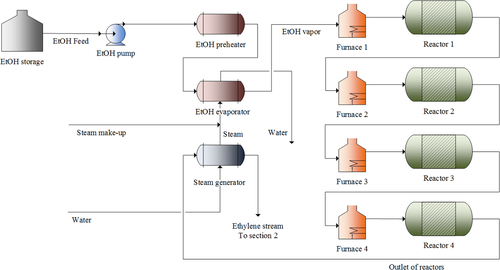
4.1.2 Recovery Step
One of the main purposes of this step is to remove the carbon dioxide, water, and the unreacted ethanol from the product. Some other impurities are also removed in this step (Fig. 9). The big difference between the boiling point of water and ethylene makes the separation process easy. The product is first cooled to 50 °C in a heat exchanger and then enters into a quench tower. Water at 40 °C is sprayed at the top of this column where the water vapor is condensed and separated from the ethylene column. Part of the condensed water is cooled and reused in the quench tower (Fig. 9). The ethylene that leaves the quench tower contains 92.1 wt % ethylene as well as 5.2 wt % water, 1.4 wt % ethanol, and 1603 ppm carbon dioxide.
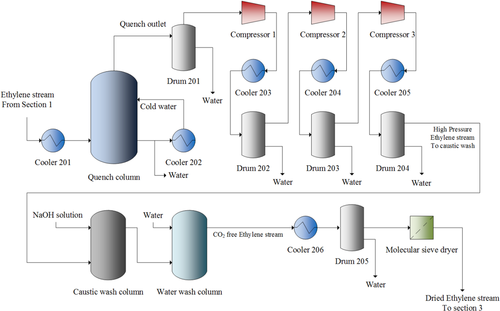
The CO2 concentration should be decreased to 5 ppm to fulfil the requirements for polymer-grade ethylene. Before CO2 removal, the ethylene stream is pressurized to 27 bar using compressors (three stages). This pressure is required in the purification step. Between the compressors, the ethylene stream is cooled down to 15 °C to condense some more water. The condensed water is separated in the knockout drums. Carbon dioxide removal is performed by dissolution in sodium hydroxide solution (in a caustic wash column). A water washing column is also used in this process to remove any possible drops of alkali solution that have been carried by the ethylene stream. Concentration of the carbon dioxide in the remaining stream is less than 2 ppm. Before entering the final purification section, it is necessary to completely remove the water. This is because the purification is performed at very low temperatures (cryogenic condition), and presence of water would damage the instruments. Final water removal is performed by molecular sieves. An ethylene stream with 99.2 wt % ethylene is sent to the final purification stage.
4.1.3 Ethylene Purification Step
Cryogenic distillation is used in this section to remove the remaining impurities from the ethylene product. A process flow diagram of this section is presented in Fig. 10.
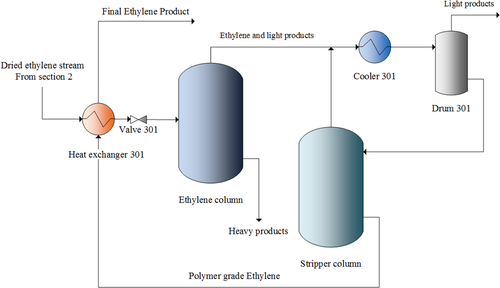
In the beginning, the ethylene stream is cooled to –23 °C. Then, it passes through an expansion valve, which reduces the temperature further to –28 °C by dropping the pressure from 27 to 22 bar. Cryogenic distillation is performed in two columns, i.e., ethylene column and stripper column. The former removes the heavy impurities from ethylene, namely propylene, butadiene, diethyl ether, acetaldehyde, and ethane. The latter removes light impurities, i.e., hydrogen and methane from ethylene. The two columns have a joint condenser (Fig. 10). An ethylene stream with a purity of 99.97 wt % is obtained at the end. The impurity profile of this product fulfils the requirements for polymer grade ethylene (Tab. 1). Finally, ethylene is warmed up to 10 °C by exchanging heat with the impure ethylene that enters the purification section (Fig. 10).
|
|
Required for the polymer grade |
Simulation results for 180 kt a−1 |
|---|---|---|
|
Ethylene [mol %] |
99.9 |
99.97 |
|
Maximum impurities [mol ppm] |
||
|
Acetylene |
2 |
0 |
|
Methane |
200 |
194 |
|
Ethane |
200 |
129 |
|
Oxygen |
2 |
0 |
|
Carbon monoxide |
1 |
trace |
|
Carbon dioxide |
5 |
less than 1.3 |
|
Total sulfur |
2 |
0 |
|
Propylene |
10 |
0 |
|
C4+'s |
10 |
0 |
|
Water |
2 |
0 |
|
Hydrogen |
5 |
0 |
|
Methanol |
5 |
0 |
|
Total chlorine |
2 |
0 |
|
Other compounds |
5 |
0 |
4.2 Simulation Hints
Aspen® plus 8.6 and Aspen Process Economic Analyzer 8.6 were used to simulate the process. Due to presence of polar components, e.g., water and ethanol, the NRTL activity coefficient model was used in the reaction section. For the caustic wash unit, a modified version of NRTL, i.e., ELECNRTL was chosen. For the purification step where the non-polar components are dominant, the Peng-Robinson equation was used. For the steam (utility), the steam table was employed. Eight parallel reactions were considered in this simulation. Stoichiometric calculations were used to model the process. Selectivity of each reaction is presented in Tab. 2 94.
|
Product name |
Reaction |
Selectivity |
|---|---|---|
|
Ethylene |
|
0.988 |
|
Diethyl ether |
|
0.00052 |
|
Acetaldehyde |
|
0.002 |
|
Ethane |
|
0.0027 |
|
Propylene |
|
0.0006 |
|
Butadiene |
|
0.005 |
|
Carbon monoxide |
|
0.00007 |
|
Carbon dioxide |
|
0.0011 |
In each of the adiabatic reactors, the conversion was set at a level where the temperature of the product was above 310 °C. For the last reactor, it was 377 °C. Ethanol conversions were 28.7, 40.2, 67.0, and 87.0 % for reactors 1 through 4, respectively. The overall ethanol conversion in this process was 98.2 %.
4.3 Simulation Results
The simulation of the process was done for two cases. In the first case, a pure ethanol 95 wt % stream was used as feed, while in the second case a feed of ethanol containing different impurities was investigated.
4.3.1 Pure Ethanol as Feed
The process simulation was performed for a product formation of 180 kt a−1. Flow rate and composition of the main streams are presented in Tab. 3. The pure ethanol (95 %) feed stream represents the ideal case that was obtained from an ethanol factory with starch as feed (1st generation ethanol).
|
Stream |
P [bar] |
T [°C] |
Flow rate [kg/h] |
Ethylene [wt%] |
Water [wt%] |
Ethanol [wt%] |
CO2 [ppm] |
Other [wt%] |
|---|---|---|---|---|---|---|---|---|
|
Reaction Step |
|
|
|
|
|
|
|
|
|
EtOH feed |
1 |
25 |
42 194 |
0 |
5 |
95 |
0 |
0 |
|
EtOH vapor |
4.5 |
121.4 |
42 194 |
0 |
5 |
90 |
0 |
0 |
|
Outlet of reactors |
1.4 |
377.1 |
42 194 |
56.11 |
41.3 |
0 |
980 |
0.75 |
|
Ethylene stream to step 2 |
1.4 |
90.4 |
42 194 |
56.11 |
41.3 |
0 |
980 |
0.75 |
|
Recovery Step |
|
|
|
|
|
|
|
|
|
Quench outlet |
1 |
41.6 |
25 449.7 |
92.1 |
5.2 |
1.4 |
1603 |
1.1 |
|
High pressure ethylene stream to Caustic wash |
27 |
25 |
23 579.2 |
98.7 |
0.028 |
0.14 |
1730 |
1 |
|
CO2-free ethylene stream |
27 |
28.3 |
22 665.4 |
99.2 |
0.053 |
0 |
0.4 |
0.775 |
|
Dried ethylene stream to step 3 |
27 |
15 |
22 637.9 |
99.2 |
0 |
0 |
0.4 |
0.768 |
|
Purification Step |
|
|
|
|
|
|
|
|
|
Ethylene and light products |
22 |
–25.7 |
22 218 |
99.87 |
0 |
0 |
0.45 |
0.125 |
|
Heavy products |
22 |
–16 |
419.9 |
65.2 |
0 |
0 |
0 |
34.8 |
|
Light products |
22 |
–40 |
342.4 |
93.5 |
0 |
0 |
0 |
6.5 |
|
Polymer grade ethylene |
22 |
–25.6 |
21 875.7 |
99.97 |
0 |
0 |
0.45 |
0.03 |
|
Final ethylene product |
22 |
10 |
21 875.7 |
99.97 |
0 |
0 |
0.45 |
0.03 |
4.3.2 Effect of Ethanol Impurities on the Quality of Produced Ethylene
In this section, the impact of the impurities of the bioethanol feed was investigated. Different types of ethanol streams can be considered as feed for the ethylene production process. In this work, four different streams were studied including E95, E100, E87, and E87cellulose. E87 is the ethanol stream from the top of aldehyde column. E87cellulose represents lignocellulosic ethanol that contains three additional impurities including furfural, acetic acid, and acetone, which are typical volatile compounds for lignocellulosic ethanol with organosolv pretreatment 95. The specifications of the E95, E100, and E87 streams taken from an industrial ethanol plant are presented in Tab. 4 together with the E87cellulose stream, which is fabricated based on E87 data. The Aspen model developed in previous parts was employed to investigate the impact of the impurity profile on the quality of the final ethylene. The results are summarized in Tab. 5. It can be seen that the impurity profile of ethanol feed does not have a significant effect on the quality of the obtained bio ethylene.
|
Composition |
E95 |
E100 |
E87 |
E87cellulose |
|---|---|---|---|---|
|
Ethanol |
0.926400 |
0.986900 |
0.871584 |
0.871584 |
|
Methanol |
0.000045 |
0.000065 |
0.000500 |
0.001150 |
|
Acetaldehyde |
0.000026 |
0.000055 |
0.001100 |
0.001100 |
|
Propanol |
0.000130 |
0.000340 |
0.000049 |
0.000049 |
|
Diethylamine |
0.000010 |
0.000000 |
0.000000 |
0.000000 |
|
Ethylacetate |
0.000009 |
0.000020 |
0.003406 |
0.003406 |
|
Isobutanol |
0.000068 |
0.000390 |
0.000044 |
0.000044 |
|
1-butanol |
0.000006 |
0.000018 |
0.000008 |
0.000008 |
|
2-pentanol |
0.000160 |
0.000000 |
0.000006 |
0.000006 |
|
Isoamyl alcohol |
0.000055 |
0.000720 |
0.000913 |
0.000910 |
|
2-methyl 1-butanol |
0.000048 |
0.000220 |
0.000469 |
0.000469 |
|
Water |
0.073042 |
0.011272 |
0.121910 |
0.117754 |
|
Furfural |
0.000000 |
0.000000 |
0.000000 |
0.001150 |
|
Acetone |
0.000000 |
0.000000 |
0.000000 |
0.001150 |
|
Acetic acid |
0.000000 |
0.000000 |
0.000000 |
0.001150 |
|
Ethanol feed |
Ethylene [wt%] |
Water [wt%] |
Ethanol [wt%] |
CO2 [ppm] |
Other [wt%] |
|---|---|---|---|---|---|
|
E95 |
99.92 |
0 |
0 |
0.45 |
0.08 |
|
E100 |
99.92 |
0 |
0 |
0.48 |
0.08 |
|
E87 |
99.92 |
0 |
0 |
0.43 |
0.08 |
|
E87cellulose |
99.92 |
0 |
0 |
0.34 |
0.08 |
4.4 Economic Evaluations
The process of ethylene production from ethanol was modelled in details and the economic calculations were performed assuming an n-th plant design, i.e., the design was based on the technologies which have already been used in commercial plants and are well understood. Annual working hours were considered to be 8000 h in this study and the project life was assumed to be 20 a. The cost estimations were performed using Aspen Process Economic Analyzer version 9. Pricing was based on first quarter of 2015. A tax rate of 25 % and discount rate of 10 % was considered in the calculations.
The prices of the major equipments in the process are presented in Tab. 6. A ten days supply for the ethanol feed has been considered to estimate the price of an ethanol storage tank (US$ 2 million). The equipment in the reaction, recovery, and purification steps have a purchase cost of US$ 2.2, 4.7, and 4.3 million, respectively. These values are in agreement with the values reported by Haro et al. 20.
|
Description |
Major equipment |
Price [US$] |
|---|---|---|
|
Ethanol storage tank |
10 day supply of ethanol to the process |
2 006 500 |
|
Reaction step |
Reactors |
229 500 |
|
Furnaces |
1 829 400 |
|
|
Other equipment |
139 300 |
|
|
Recovery step |
Quench system |
265 100 |
|
Compression system |
4 245 700 |
|
|
Caustic and water wash system |
90 200 |
|
|
Dehydration system |
72 500 |
|
|
Purification step |
Ethylene column |
3 811 500 |
|
Stripper column |
152 800 |
|
|
Other equipment |
395 000 |
|
|
Ethylene storage tank |
2 h storage |
860 500 |
|
24 h storage |
39 877 000 |
|
|
48 h storage |
80 808 000 |
The price of an ethylene storage tank (a sphere tank) considerably varies with the ethylene storage time. If there would be the possibility of direct consumption of the ethylene in another unit (e.g., a polymerization unit) a short residence time of 2 h seems to be reasonable. For this residence time, the price of the ethylene storage tank is about US$ 0.86 million. For longer storage times however, the price of the storage tank would be significantly higher with respect to other equipment. The price of the ethylene storage tank represents 6, 72, and 83 % of the total purchase costs of the equipment for residence times of 2, 24, and 48 h, respectively. Therefore, building the ethylene production plant next to the plant that consumes ethylene will significantly reduce the investment costs and improve the economy. The details of the projects capital costs for different ethylene storage times are presented in Tab. 7. According to the results, the total project costs are significantly affected by the ethylene storage time. However the annual operating costs are not significantly affected by the ethylene storage time (Tab. 8).
|
Cost item |
Cost [US$] of the process for different ethylene storage times |
||
|---|---|---|---|
|
2 h |
24 h |
48 h |
|
|
Purchased equipment |
14 223 601 |
55 271 100 |
97 430 112 |
|
Equipment setting |
155 146 |
155 146 |
155 146 |
|
Piping |
4 594 580 |
7 233 566 |
10 218 564 |
|
Civil |
2 338 493 |
4 221 064 |
5 969 494 |
|
Steel |
216 330 |
617 920 |
12 505 832 |
|
Instrumentation |
2 886 514 |
3 482 904 |
3 771 301 |
|
Electrical |
2 084 340 |
2 088 153 |
2 089 465 |
|
Insulation |
1 071 763 |
1 454 079 |
1 671 084 |
|
Paint |
202 131 |
203 677 |
207 494 |
|
Other |
9 638 200 |
12 505 101 |
15 975 900 |
|
G and A overheads |
965 688 |
2 447 508 |
3 982 042 |
|
Contract fee |
1 323 328 |
2 476 161 |
3 697 020 |
|
Contingencies |
7 146 020 |
16 588 148 |
26 355 276 |
|
Adjusted total project costs |
51 357 006 |
119 215 670 |
189 410 047 |
|
Cost item |
Operating costs [US$ a−1] of the process with different ethylene storage times |
||
|---|---|---|---|
|
2 h |
24 h |
48 h |
|
|
Operating labor cost |
1 240 000 |
1 240 000 |
1 240 000 |
|
Maintenance cost |
518 000 |
1 990 000 |
3 550 000 |
|
Operating charges |
310 000 |
310 000 |
310 000 |
|
Plant overhead |
897 000 |
1 615 000 |
2 395 000 |
|
G and A cost |
24 672 514 |
24 849 392 |
25 036 592 |
|
Total Utility costs |
9 763 874 |
9 766 850 |
9 766 850 |
The main raw material is 95 wt % ethanol. This is considered to be supplied from an ethanol plant, e.g., in Sweden with a cost of 0.85 US$ kg−1. A transportation cost of 0.08 US$ kg−1 is added to the price of ethanol for a typical 400 km distance between the ethanol supplier and the ethylene plant. Therefore, a value of 0.93 US$ kg−1 ethanol is considered for economic calculations. The current price of fossil based ethylene is 1.01 US$ kg−1. The difference between the revenue from the sales of the product (1.77 × 108 US$ a−1) and the cost of the raw materials (3.14 × 108 US$ a−1) is considered the profit margin, here –1.8 × 10−8 US$ a−1 for a production capacity of 180 kt a−1. The negative profit margin indicates that the process is not profitable with the above prices for raw materials and products. Accordingly, at current prices, the net present (NPV) value of the project will be negative. Tab. 9 presents the minimum required price of the product or the maximum required price of the raw material which result in NPV = 0. For example, when the ethylene storage time is 2 h, an ethylene price of 1.8606 US$ kg−1 is required to achieve NPV = 0, which means the project would give a 10 % rate of return on investment. Alternatively, with the current price of ethylene, reduction of the ethanol price to 0.4814 US$ kg−1 is required to get NPV = 0 (Tab. 9).
|
Ethylene storage time |
Ethanol price [US$ kg−1] |
Ethylene price [US$ kg−1] |
NPV [US$] |
|---|---|---|---|
|
2 h |
0.93 |
1.01 |
–1.62 × 109 |
|
0.4814 |
1.01 |
0 |
|
|
0.93 |
1.8606 |
0 |
|
|
24 h |
0.93 |
1.01 |
–1.67 × 109 |
|
0.4546 |
1.01 |
0 |
|
|
0.93 |
1.9093 |
0 |
|
|
48 h |
0.93 |
1.01 |
–1.74 × 10-9 |
|
0.4251 |
1.01 |
0 |
|
|
0.93 |
1.9627 |
0 |
It should be noted that the bioenergy with carbon capture and storage (BECCS) for the ethanol feedstock is not included in the economic calculations of this case study. If BECCS is taken into account for the case studies, the results may be substantially enhanced as reported by Haro et al. 20. They studied five different potential processes to produce ethylene from biomass and concluded that two cases (Brazilian ethanol and the estimated price of ethanol via the indirect synthesis of syngas) would enable the cost-competitive production of ethylene. However, all cases, except for the case of bioethanol from biochemical processing, would be profitable if BECCS is taken into account. Another solution to lower the production costs and to save energy in the process is the integration of the ethylene production unit with a 1st and 2nd generation ethanol production unit. In this scheme, the produced ethanol after initial purification steps can be used as the feedstock for the ethylene production. The techno-economic study of such a plant as well as sensitivity analysis remains as a future work.
5 Concluding Remarks
Ethylene is one of the most important chemical intermediates produced by steam cracking of petroleum liquids and natural gases. Catalytic dehydration of bioethanol is an alternative route for production of ethylene, which reduces the greenhouse gas emissions and dependency on limited fossil fuels. First and second generations of bioethanol can be used as the feedstock for manufacturing of ethylene. However, the contaminants in the second generation of bioethanol may have an impact on the process. Results showed that the impurities in the ethanol feed do not affect the quality of the produced bioethylene, significantly. Therefore, it is not necessary to perform all the purification steps in an ethanol plant to get a proper feed for ethylene production. Economic evaluation showed that the process is not profitable with the current prices for raw materials and products. Taking into account the BECCS for the feedstock ethanol may change the profit margins and, consequently, enable the cost-competitive production of ethylene. The ethylene production unit can also be integrated into 1st and 2nd generation ethanol production units where the ethanol feed stock is the product of the ethanol plant before the final purification steps. These studies remain as future work.
Acknowledgements
This work was financed by the Swedish Research Council (Formas), Sweden. We appreciate Chematur Engineering AB for providing consulting services in this study.
The authors have declared no conflict of interest
Abbreviations
-
- ACC
-
1-aminocyclopropane-1carboxylic acid
-
- ACO
-
ACC oxidase
-
- ACS
-
ACC synthase
-
- BECCS
-
bioenergy with carbon capture and storage
-
- DDGS
-
dried distiller grains with solubles
-
- DME
-
dimethyl ether
-
- EFE
-
ethylene forming enzyme
-
- KMBA
-
2-keto-4-methylthiobutyric acid
-
- LHSV
-
liquid hourly space velocity
-
- NPV
-
net present value
-
- SAM
-
S-adenosyl methionine
-
- SAPO
-
Si-Al-phosphate
-
- SHOP
-
Shell higher olefin process
-
- TCA
-
cyanobacterial tricarboxylic acid
Biographies

Abas Mohsenzadeh received his B.Sc. in Chemical Engineering from Isfahan University of Technology (IUT), Iran, in 2007. From 2008 to 2015, he worked for his M.Sc. in Industrial Biotechnology and his Ph.D. within the Resource Recovery area at the Swedish Center for Resource Recovery at the University of Borås, Sweden. Since 2015, he is postdoctoral researcher at the University of Borås working within computational modelling, combustion and thermal processes as well as biotechnology groups. His scientific interests include molecular modeling and computational simulation of chemical processes from micro to macro levels.

Akram Zamani received her Ph.D. in Biotechnology from Chalmers University of Technology, Sweden, in 2010. She then worked as an assistant professor at Isfahan University of Technology in Iran for three years. In 2014, she joined the Swedish Centre for Resource recovery and since then, she is working as a senior lecturer at the University of Borås, Sweden. Her research mainly deals with the development of different biopolymer-based products (e.g., super-absorbents and bioplastics) as well as process simulations using Aspen plus.

Mohammad J. Taherzadeh, received his Ph.D. in Biosciences in 1999 from Chalmers University of Technology in Sweden after having obtained a B.Sc. and M.Sc. in Chemical Engineering. He worked at different universities and companies on bioprocess development, until in 2004, he became professor in Bioprocess Technology at the University of Borås, Sweden. He is currently the head of the research school at the Swedish Centre for Resource Recovery. With more than 200 publications in scientific journals and books and patents, he is developing bioprocesses to convert wastes and agricultural residuals to value added products in form of energy and materials.














